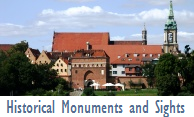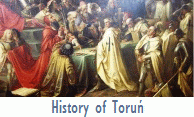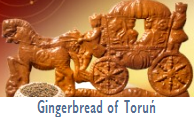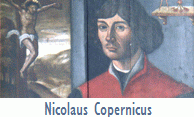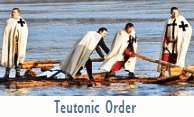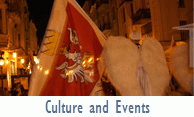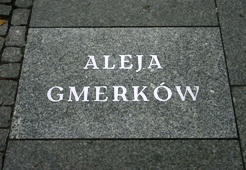 In October 2007, the Walk of Merchants’ Marks was unveiled in Żeglarska street. Here, in the flagstones between Kopernika and Rabiańska streets in the Old Quarter, 25 Toruń medieval merchants’ marks have been placed, which were used by merchants to mark their commodities. Not all the names of merchants engaging in great international trade within the Hansa and active in other spheres of life have been included here. In October 2007, the Walk of Merchants’ Marks was unveiled in Żeglarska street. Here, in the flagstones between Kopernika and Rabiańska streets in the Old Quarter, 25 Toruń medieval merchants’ marks have been placed, which were used by merchants to mark their commodities. Not all the names of merchants engaging in great international trade within the Hansa and active in other spheres of life have been included here.The first merchants - the inhabitants of the Old City of Toruń originated from Silesia, Lusatia and Rhineland. At the turn of the 14th century, the number of the Westphalia people in Toruń was growing quickly. All of them saw an opportunity to accumulate wealth by participating in a profitable commodities exchange between Poland, Russia, Hungary, a well as Western and Northern Europe. Affluent merchants, mostly drapers, shortly (as early as in the 13th century) rose to power in Toruń. In the 14th century, the Westphalia merchants occupied a highly influential position in the City Council. At the time, the first religious and merchant associations were beginning to form. As early as the late 13th century, Merchant Brotherhood of St. Mary was established, followed by the Brotherhood of St. George in 1311 and finally Artus House. i 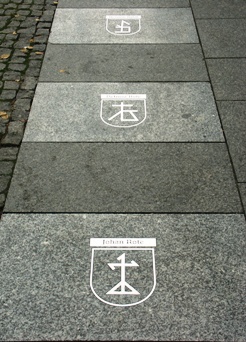 Toruń merchants conducted highly profitable financial and commodities transactions. The surviving customs statement specifying the custom duties charged from the Hanseatic merchants reveals that a certain Godfried von Allen, Toruń merchant (trading mainly Hungarian copper and wax), a councillor and subsequent burgomaster, in 1368-1371 exported commodities worth a total of nearly 9 thousand ‘grzywnas’ (a historical monetary unit in Teutonic Prussia) to the West. It was an exorbitant amount of money: in the mid-15th century, the annual income earned by St. Johns’ Cathedral parish priest in Toruń totaled 200-300 grzywnas, while Toruń apprentice’s average monthly income was just barely one grzywna. Toruń merchants conducted highly profitable financial and commodities transactions. The surviving customs statement specifying the custom duties charged from the Hanseatic merchants reveals that a certain Godfried von Allen, Toruń merchant (trading mainly Hungarian copper and wax), a councillor and subsequent burgomaster, in 1368-1371 exported commodities worth a total of nearly 9 thousand ‘grzywnas’ (a historical monetary unit in Teutonic Prussia) to the West. It was an exorbitant amount of money: in the mid-15th century, the annual income earned by St. Johns’ Cathedral parish priest in Toruń totaled 200-300 grzywnas, while Toruń apprentice’s average monthly income was just barely one grzywna. Accumulating such wealth was not only conducive to enriching merchant families and their homes, but it was highly profitable for the city as well. It is the medieval period – when Toruń was at the peak of its prosperity – that the most precious Gothic buildings and objects come from. i 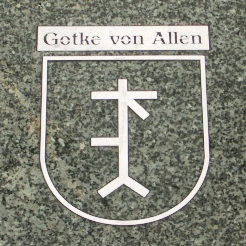 The von Allens The von AllensThe von Allens came from Westphalia. They were a merchant family and soon earned a large fortune and significance. Some of them were highly meritorious for Toruń, like, for example, Herman von Allen, a juror in 1307 and a councillor since 1320 along with Heinrich von Allen. His successor was Bertram von Allen, the councillor in 1349-62, followed by Gotke and Herman II, Toruń councillors and burgomasters, who represented Toruń on the Hansa meeting in Lübeck in the second half of the 14th century. By the end of the 18th century, St Johns’ Cathedral had housed a brass epitaph for Gerhard von Allen, depicting a father, a mother and a grandfather surrounded by 11 children. The family employed a priest to pray at their private altar not only for the souls of the founders and their relatives, but also, for example, for the end of the war, the city and even successful financial operations. Other family members worth mentioning include: Tillman I (d. 1437) – the founder of the Altar of the Three Kings in St Johns’ Cathedral; Bertram III (d. 1469) – Toruń councillor and burgomaster, an eager advocate of an agreement with Poland before the Thirteen Years’ War, a member of the war committee in 1463; Tillman II (d. 1499) – Toruń councillor and burgomaster; the leader of Toruń army in the battle of the besieged town of Świecie during the Thirteen Years’ War; a starost and commander of Świecie castle won by the people of Toruń in 1461; twice a royal burgrave in Toruń; in collaboration with Berthold Becker, he founded the Altar of St. Andrew in St Johns’ Cathedral; Bertram IV (d. 1503) – Toruń councillor since 1482, a burgomaster in 1500; Lucas – a starost in Rogóźno in 1511. 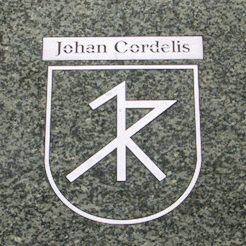 The Cordelises (Kordelitz, Cordelich) The Cordelises (Kordelitz, Cordelich)The family settled in Toruń in the 13th century. Johan Cordelis (d. 1384) traded Hungarian copper, iron, lead and mercury. He became Toruń councillor in 1356 and a burgomaster in 1374. He was widely respected and largely significant both for the city and the Teutonic Grand Master’s court. He was often in command of Toruń army who obligatorily participated in Teutonic wars, both on the land and the sea. He distinguished himself in the battle of Visby in Gothland during the war with Denmark. His successor in the City Council was Andrew Cordelis, a juror since 1497 and a councillor since 1411, appointed by the Grand Master. The City Council refused to accept the nomination, right in considering it a violation of its own and the city’s rights. The nominee himself was never invited to the City Council meetings nor assigned tasks or reports. In his last years of life, he was a judge of the Chełmno Land and fell victim to the plague in 1416. Barbara Cordelis was an abbess of Chełmno cloister. 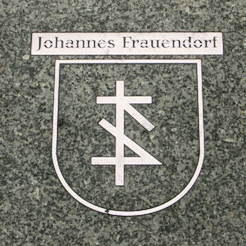 The Frauendorfs (Frauendorp) The Frauendorfs (Frauendorp)Johannes Frauendorf was Toruń merchant in the 14th century. He soon departed from the city, leaving his brother, Gotfried Frauendorf, there. Gotfried, also a merchant, juror and city councillor since 1394, stayed in Toruń till his death in 1405. Other members of the family remain unknown. i 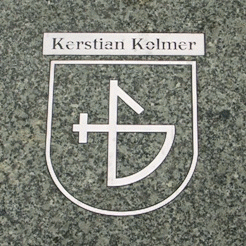 The Kolmers (Colmer, Kielmer) The Kolmers (Colmer, Kielmer)The Kolmers arrived in Toruń soon after the foundation of the city, as early as the 13th century. Dietrich Kolmer was the first to become a City Councillor in 1262. Some of them owned land like, for example, Benedict Kolmer who was the owner of Szonewo near Grudziądz. He was married to Catherine Gefels, Chełmno councillor’s daughter. i 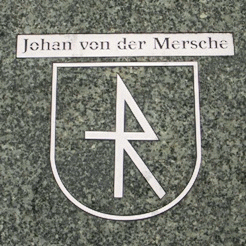 The von der Mersches The von der MerschesThe family came from Lübeck. Johan von der Mersche had been Toruń councillor since 1396 until his death in 1422. Chronicles describe him as shrewd and enterprising. He was repeatedly sent on missions abroad. During the battle of Grunwald in 1410, he was taken captive by the Polish. Released soon afterwards, he returned to Toruń safe and sound. Other members of this family include Michael, mentioned in 1661, and Simon, Toruń councillor of 1766-74, who was the last Catholic Toruń councillor and the last to have a merchants’ mark included in his signet ring. i 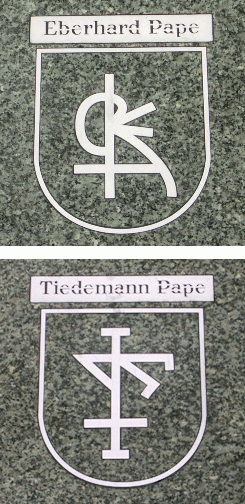 The Papes (Papaw, Pfaffe) The Papes (Papaw, Pfaffe)The Papes arrived in Toruń within the first century after the foundation of the city and were active in the 14th and 15th centuries. As early 1305, Johan Pape became Toruń councillor and in 1312-20 Toruń burgomaster. His successor, Tiedeman, known as a ‘stepfather’ of St Johns’ Cathedral became the councillor in 1347 and a burgomaster in 1363-4. His son, Eberhard, was a juror in 1364 and a councillor in 1370. Eberhard II Pape was a juror in 1390, city councillor in 1394 and the owner of Wytrębowice property near Toruń, as well as the founder of incumbency for St Johns’ Cathedral. Johan II Pape became a juror in 1415, and shortly afterwards, in 1416, a councillor. However, he died of the plague in the same year. The last of the patricians was Eberhard III, a juror since 1442 and a councillor in 1446-53. Other known members include, for example, Lamprecht, a juror in 1368-97; Peter – a juror in 1422, a patron of the Altar of the Holy Cross in St Johns’ Cathedral; Herman – a juror in 1456 and the owner of the village of Wybcz near Toruń, and others. i 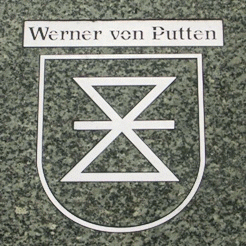 The Puttens (von Putten, Potten) The Puttens (von Putten, Potten)The Puttens came from Dortmund and settled in Toruń in the 13th century. The first person to distinguish himself was Werner Putten, who became a juror as early as 1332, a councillor in 1349 and a burgomaster in 1253. He died in 1376. His son, Johan, a draper, became a juror in 1379, a councillor in 1382 and a burgomaster in 1386. He died in 1405 regarded as the highly meritorious and highly considered father of the city. He repeatedly took part in Prussian or Hansa meetings in Malbork (Marienburg) or Lübeck respectively as the Toruń City Council representative. The last patrician in the family was Johan II, who became a juror in 1422 and a councillor in 1427. He died during the plaque in 1439. 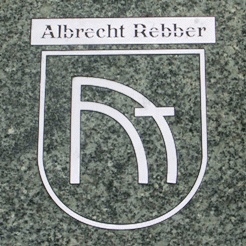 The Rebbers (Reber, Riber, Rober) The Rebbers (Reber, Riber, Rober)The Rebbers were a merchant family from Westphalia (Soest) which settled in Toruń in the 13th century and traded wax (especially Albrecht I, Albrecht II, Dietmar I). The first person to become a councillor in 1308 was Tideman. The second was his son Albrecht, a councillor in 1350, a highly considered man, who died in 1393 and who was frequently sent as a legate. In the meantime, Dietmar served as juror from 1350, a councillor from 1351 and a burgomaster in 1362. He died in 1266. Albrecht II became a juror in 1363. Dietmar was a juror from 1379 and a councillor from 1372. Largely significant was Gotke, a juror since 1379, a councillor since 1383 and a burgomaster in 1388, who was often sent to Hansa and the Royal court in Krakow as a legate. He lived to the Polish and Teutonic war in 1410 and, together with other six councillors, was removed from the Council by the Grand Master for his pro-Polish beliefs in 1411. He died shortly afterwards. The subsequent family members were not councillors despite being patricians. The last known member of the Rebbers family – Albrecht III was a leaseholder of Piwnice near Toruń in 1414. Later, he bought a Frankenau grange and thus he became part of the landed gentry in the Chełmno Land. 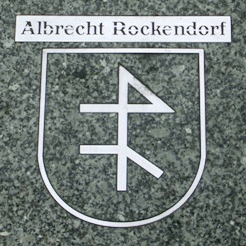 The Rockendorfs (von Rackendorf, Rogindorff, Ruckendorf) The Rockendorfs (von Rackendorf, Rogindorff, Ruckendorf)The Rockendorfs settled in Toruń in the 13th century. A lot of meritorious men came from the family. They were merchants or bankers and made loans even to the Princes of Mazovia. As early as 1300, Heinrich Rockendorf had financial contacts with Bolesław, a Prince of Mazovia, which undoubtedly fostered his becoming a member of the City Council in 1305 and becoming a Toruń burgomaster in 1320. In the 1540s he founded the first chapel near the north nave of St Johns’ Cathedral. At the same time Werner Rockendorf held the office of a city councillor in 1308, while another Rockendorf, Ludeke, was a councillor in 1326 and a burgomaster in 1339. He died in 1347. In 1340 Johan Rockendorf became Toruń councillor, followed by Werner II, while Gotke, a councillor since 1351, held the office for 20 years until his death in 1371. Johan II was a juror in 1363 and a councillor in 1369. He died in 1376 after holding the office for 18 years. Johan III became a juror in 1456 and a councillor in 1460. He eagerly fulfilled his duties for 20 years. He started by founding an altar in St. Johns’ Cathedral. Having always been an open advocate of a peace agreement with Poland, he took an active part in the war between Poland and the Teutonic Order. His services and military successes must have been highly appreciated, because he and his military colleague and Toruń councillor, Johan Ziegenhals, were presented Bierzgłowo Castle grange by Polish King Kazimierz Jagiellończyk (Casimir Jagiellon). In return for 400 silver grzywnas which he once lent to the King for military purposes, he was given Gronowo estate as security. He died in 1483 and was the last, and yet the most outstanding patrician in the family. 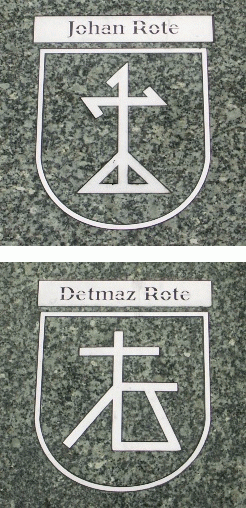 The Rotes (von Rothe) The Rotes (von Rothe)The family settled in Toruń in the 14th century. As early as then, the sources mention such people as Johan, Dietrich and Dietmar Rotes as affluent merchants. Among the three of them, Johan was Toruń councillor since 1354 and remained in the same office till his death in 1382. Albrecht became a juror in 1379, a councillor in 1398 and then the burgomaster of Toruń in 1496. He died in 1421 as a largely significant and influential man. He was the leader of the Teutonic party in the city during the war in 1410 and for this reason he was designated by the Teutonic Grand Master to hold peace negotiations with the King of Poland. He also led the detachment of 214 Toruń soldiers into the battle of Grunwald in 1410. At the same time other members of the family, i.e. Peter and Roger, as the supporters of the Teutonic Order took an active part in the battle of Złocieniec (Falkenberg) in New March, the first being a leader, the second the leader of Toruń army summoned by the Order. The last of the Rotes was Werner, a councillor in 1404, who, during the war in 1410, supported the Polish cause against his family’s will. For this reason he was removed from his office by the Teutonic Order shortly after the truce of 1411. i 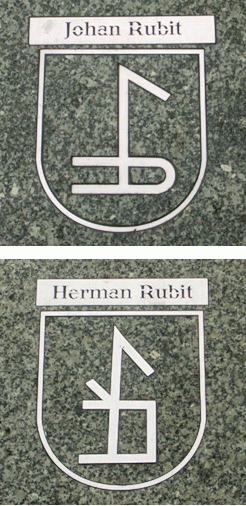 The Rubits (Rubitt, Rubis, Robit) The Rubits (Rubitt, Rubis, Robit)The Rubits came from Lübeck and settled in Toruń in the 13th century. Throughout the Middle Ages, a number of them deserved praise for their achievements in the city. The first person to gain much significance was merchant Johan Rubit, who in 1295, with Prince Władysław Łokietek's (Ladislaus the Elbow-High’s) permission, was building a hospital in Brześć Kujawski in Kuiavia and who was Toruń councillor in 1304-08. He was succeeded by Herman in 1357 and Johan II in 1371, who died shortly afterwards in 1372. Other successive councillors included Eberhard I in 1375, Johan III in 1399, Eberhard II in 1420, who died later that year, Johan IV in 1424-39 and, most importantly, Gotke, a councillor since 1450, who had held the office of a juror 5 years before. After the outbreak of the Thirteen Years’ War in 1454, he entered the war on the side of the Polish and was appointed a commanding officer of Teutonic town of Brodnica by the Prussians. His knightly virtues and merits were acknowledged by Polish King Kazimierz Jagielończyk (Casimir Jagiellon) who rewarded him with Brodnica castle regained from the Teutonic Order. In a surviving letter, his brother Reineke congratulates him on the royal favour, which, however, won him disapproval in the city. The opposition formed and Gotke was confined in Toruń prison for a short period of time, from which he was released by the King’s order. The incidents, however, made him depart from Toruń and settle in Brodnica, where he merged with the landed gentry of the Chełmno Land by virtue of his landed estate, similarly to his brother Reineke. As a representative of the Chełmno Land, Reineke pledged loyalty to King Casimir Jagiellon as early as 1457, after which he leased the village of Papowo from Toruń. From then on, the Rubit family amalgamated with the landed gentry and disappeared from Toruń. i 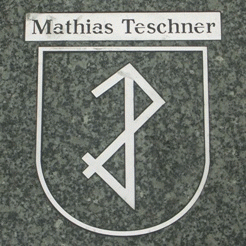 The Teschners (Teschener) The Teschners (Teschener)The Teschners were a merchant family which presumably originated from the town of Cieszyn (Teschen) and hence the name – the Teschners. They originally settled in Lviv in the 14th century (as mentioned in the local sources), from where they moved to Toruń. Here, two Teschners became city councillors. The first of them, Mathias, a juror in 1443, Toruń councillor in 1445, and a burgomaster in 1461, died in 1464. Along with his brother, Martin, they run a large department store, trading grain, domestic timber, tar, leather and other such things. Besides, he generously donated money for charity and lent significant sums to the King and Princes of Poland. In the then policy he took the side of the Polish and belonged to the party opposing the Teutonic Order. Another city councillor was Mathias’s son and heir Johan. Appointed a juror in 1475, he became a city councillor in 1478 and died in 1483. Other known members of the family include Martin, Toruń juror of 1451-63, Georg, St. Johns’ Cathedral parish priest in 1448 and another Martin, the owner of a signet seal of 1503.
|
| All rights reserved Toruń 2005-2009 | About us | CenterMedia |





